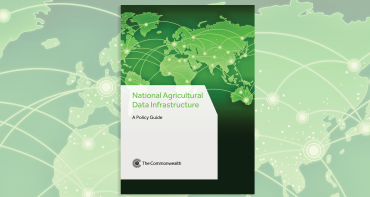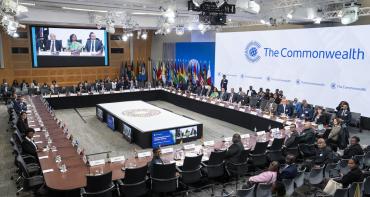Insurers, multinationals, investment banks and hedge fund managers were among the global financiers expressing support for the Commonwealth’s Regenerative Development to Reverse Climate Change (RDRCC) initiative on 27 June at Marlborough House in London.

Insurers, multinationals, investment banks and hedge fund managers were among the global financiers expressing support for the Commonwealth’s Regenerative Development to Reverse Climate Change (RDRCC) initiative on 27 June at Marlborough House in London.
Launched last month at a high-level meeting with world leaders and climate experts, RDRCC proposes a groundbreaking, integrative framework for helping countries develop evidence-based strategies that shift predominant models from ones based on exponential growth and extraction to ones that engage living, evolving systems capable of regenerating communities and the planet.
Paul Hawken, Director and Editor of Project Drawdown, introduced the Drawdown initiative as a mathematical illumination of the one hundred most promising opportunities for the world to drastically reduce carbon from the atmosphere, save money, and begin addressing climate as an integrative, whole-systems challenge.
He began by saying that humanity has never lived over 300 parts per million (ppm) of atmospheric carbon in its entire two-million-year history. And since we have no memory, knowledge, or archaeological history that tells us what happens over 300 ppm, we are in uncharted territory.
He went on to critique the current approach to global warming, which focuses on mitigation and adaptation rather than on solving the problem. He challenged this notion, saying that if we do not name the goal we will never achieve it.
“What we did at Project Drawdown is map, measure and model the 100 most substantive solutions to reversing global warming.”
Attendees were surprised to learn that educating girls, reducing food waste, and promoting indigenous land rights were shown by the data to be among the most effective opportunities for reducing global warming.
Paul Hawken also pointed out that geothermal energy has the potential to remove 16.6 gigatonnes (gt) of carbon dioxide from the planet’s atmosphere and, importantly, save the world economy more than a trillion US dollars. Attendees were impressed at how diversified the solutions were and how they would not only regenerate the environment but save costs as well.
Dr. David McConville, co-chair of the Buckminster Fuller Institute, spoke about how these opportunities can be applied as part of an integrated, regenerative approach on local, regional and global levels.
“The Global Footprint Network has calculated the footprint of human beings on the planet based on the countries they live in. Their calculations indicate that if everyone lives like the United States it will take five earths every year for us to have a sustained presence on this planet. So the very notion of sustainable development is insufficient. We have to actually go much much further than we have in the past and … undergo a paradigm shift in this regard,” he said.
Dr. McConville added: “We can’t address global challenges in isolation, and as we start to consider what is the next phase beyond sustainable development, we have to move beyond just capital access, technology access, and really think about these issues qualitatively. The notion of regenerative development is not only affiliating with, restoring and mimicking nature, but actually realising that we are part of this system.”
Ben Haggard, Principal and Co-Founder of Regenesis, elaborated that the regenerative development model is founded on the pillars of integration, a focus on what is essential in a place, realising growth potentials, creating reciprocal, mutual benefits and understanding how ecosystems operate.
He said, “A regenerative approach is always developmental, meaning that it’s working to grow the capacity of the living systems that we are working in. Creating wealth requires enabling people and other living beings to deliver their best, to go beyond what they are currently capable of delivering.
"Failure to do this is a waste of talent and therefore of capital. Regenerative projects by definition seek to develop the inherent potential in everyone they touch—this is how communities become regenerative. They build the capacity to become self-managing, self-investing and self-evolving.”
Secretary-General Patricia Scotland, who convened the meeting in collaboration with the Cloudburst Foundation, called for a “paradigm shift”.
She said, “Today was truly amazing - we sat in a room with billions of potential funding from around the globe, and we heard expressions of support and enthusiasm for this initiative. This is evidence that we are making waves. People understand that integrated approaches are imperative.”
She went on to reiterate the potential of implementing such an initiative throughout the Commonwealth of Nations saying, “Sixty percent of our Commonwealth population is below the age of 30—that’s a challenge and an opportunity. We need an economy that will be able to produce and drive employment for our young people and give them hope.
"Climate change will affect us whether or not we can provide this hope, because storms, sea-level rise, and desertification are forcing governments to adjust their development strategies to cater to volatile environmental changes. So climate change is a governance issue, a legal issue, a land rights issue and a migration issue—and it is certainly a financial issue.”
The Secretary-General continued, “For investors, climate change is a risk factor. We’ve now got the lowest levels of growth since 1945. We want to give every Commonwealth country the gift of the regenerative development model, which is a win-win because it will repair the damage we have done to the environment while simultaneously providing opportunities for economic growth. But it must be packaged in a strong financing mechanism.”
Last year the Commonwealth Secretariat opened the doors of its Climate Finance Access Hub which is helping countries to successfully bid for otherwise difficult to access climate funds.
Secretary-General Scotland closed by reminding us of the Commonwealth’s long-standing commitment to climate action. She said, “The Commonwealth has been calling for collective action on climate change since 1989 when leaders adopted the Langkawi Declaration. Five years later, the Secretariat facilitated the Barbados Programme of Action for the Sustainable Development of Small-Island Developing States, and in 2009 Commonwealth Heads signed the Port of Spain Climate Change Consensus: The Commonwealth Climate Change Declaration.
"In 2015 the Commonwealth family banded together to help deliver the historic climate change deal in Paris. In November, we will offer a proposal that goes even further: The RDRCC model with a tailored action plan for the international community at COP23. Once again, the Commonwealth will lead climate change efforts—this time focusing not on mitigation or adaptation, but on an integrated strategy for reversing global warming and transforming our current models in ways that work for not just some but for everyone."



